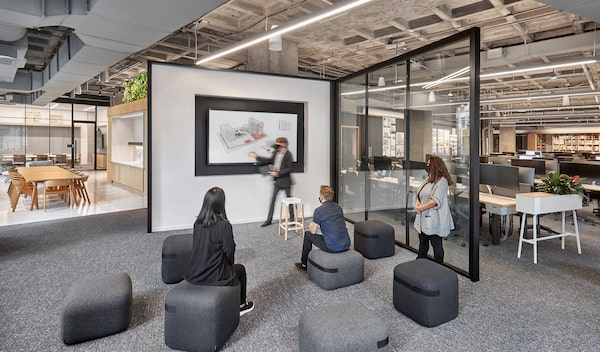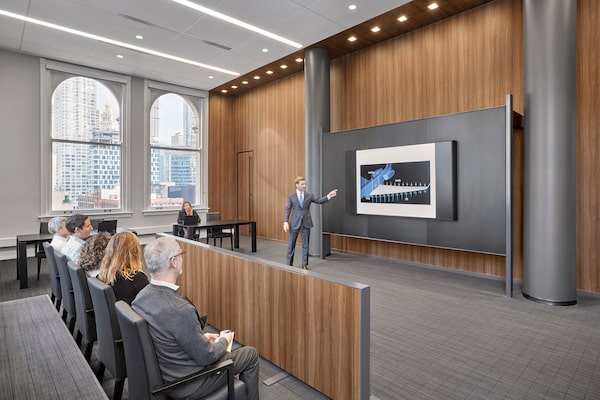
Interior Design Director Brent Capron and his Perkins & Will team created this media zone for office at 1250 Broadway in New York.
I think you’re on mute. Can you hear me? Yes, but now you’ve turned off your camera.
This will sound all too familiar if you’ve connected to a virtual conference from home during the pandemic. And while increasing numbers of workers are returning to the office, the hybrid model seems destined to persist. That means making virtual meetings more seamless and professional has become a priority for organizations large and small, experts are finding.
“Each and every one of our clients is spending a disproportionate amount of the change budget for their office space in technology and video conferencing. And that’s across the board. They’re investing in making studios that are professional grade, everything from lighting to sound to background and branding,” says Stan Krawitz, vice-chairman, Canada, for global real estate company Savills.
“To ensure the success of hybrid teams in the workplace, the communication between in-office and remote needs to feel slick, not sticky, with the means for collaboration and presentation akin to a broadcast or media studio,” says Janine Grossmann, principal and corporate interiors practice leader at Perkins & Will’s Toronto studio. In addition to growing interest in podcast studios, Perkins & Will is also working with a client planning to install an in-house photography studio.
The communication between in-office and remote needs to feel slick, not sticky, with the means for collaboration and presentation akin to a broadcast or media studio
— Janine Grossmann, principal of corporate interiors at Perkin & Will Toronto
“This integration of new technology shouldn’t just be confined to conference or meeting rooms. Increasingly, our clients are looking for office infrastructure that’s flexible enough to support informal, impromptu meetings with team members out of the office,” she adds. “Part of this impetus is also about ensuring that remote employees still feel included and are not ‘left behind’ as a percentage of the work force returns to the physical environment.”
Working remotely doesn’t have to mean isolation
Annie Bergeron, design director and principal at architecture and design firm Gensler, says that an improved ability to meet remotely and still feel as though the meeting is in person is “one of the good things that can come out of COVID.”
“It will be a big change in every sense and hopefully all for the best.”
Broadcasting studios should try to provide a better and more equitable experience, she suggests.
“We work with many of the big tech companies, and they are all looking at investing in better audio and visual facilities to broadcast to a crowd that will continue to work asynchronous schedules,” Ms. Bergeron says.
She cites one of Gensler’s clients, Brain Station, a digital skills training program that delivered 100 per cent of their programs in person before the pandemic.
“They’ve brought us in to help them create studios for teaching staff to conduct live classes virtually.”
A media studio doesn’t need to be very large and can have dual functions, she adds. “One we are working on now is only about 400 square feet and can be used as a lounge when it’s not in use for productions. We have studio lighting in the ceiling and broadcast-quality cameras and a large green screen. We’re also adding a space on the side with good lighting for preparing the guests and doing makeup.”
The trend is moving into even the most traditional of organizations, says Matthew Kobylar, design director of Gensler Toronto. “Law firms had resisted this in the past because they’re very traditional and among the last to still have individual offices. But during the pandemic, lawyers had to work from home, and many found that they could be quite productive – so that genie’s out of the bottle.”
At the same time, courts all shut down, and with a backlog of cases, many are looking to virtual hearings, Mr. Kobylar adds. “They’re realizing they can clear cases faster and you don’t have to worry about having a large courtroom available on a certain date for every judge. It can give courts much more flexibility for scheduling cases, so you can have large courtrooms for in-person trials and smaller ones for virtual meetings in judge’s chambers.”
Gensler is working with law firms across Canada to develop digital hearing rooms. While still in beta stage, they are about 20 feet by 30 feet, with seating capable of accommodating an entire legal team.
Furniture is set up so it can be flexible, facing the judge’s screen at the front, with a second screen that displays evidence. There can also be a director to select feeds from different cameras, Mr. Kobylar says. To ensure confidentiality when needed, there is increased sound absorption and partitions and doors that have automatic drop seals to prevent sound leakage.
A lot of what tech companies were experimenting with before the pandemic is now being deployed for companies with people no longer tethered to one desk, says Bill Nankivell, chief executive officer of B+H Architects.
Level of equality
One of the challenges of hybrid workplaces is designing a level of equality for those who are on a TV screen, he says. The firm has developed a prototype in its Seattle and Toronto offices called Sandbox, a media room that measures about 550 square feet.
“It starts with seating arranged in a circle with no big board table in the middle,” Mr. Nankivell says. “Gathering in a circle is more egalitarian than a traditional boardroom layout, which many find intimidating.”

Gensler designed a mock courtroom studio for law firm Barlitt Beck in Chicago.
Cameras are arranged around the room. “In a meeting with video at the end of a long table, you can end up being a small head in the corner. You want your head to be as big as everyone else’s,” he explains.
The Toronto studio’s Sandbox is furnished with swivel chairs, benches and high-top stools for adding participants in larger meetings. “We don’t have fixed cameras; we can move cameras on tripods around depending on the configuration. Lighting in the ceiling is enhanced with ring lights, which provide more even lighting on faces.”
The Sandbox is designed for multiple uses including staff meetings, conferences with clients and gatherings after work. “Organizations that are moving to a hybrid model are still asking what has to happen in their physical built spaces to continue to justify the cost of keeping them. They need to know they’re getting the most value out of the investment,” Mr. Nankivell says.
But professional media presence is destined to provide immediate payoff in a competitive advantage, Mr. Kobylar notes. Whether it’s a merger and acquisition in the corporate world or litigation in the legal world, the result will fine-tune appearance and presentation, he says.
“Even if it is 5 per cent better digital experience coming from your team, it’s going to make a difference to whether your case is heard more favourably than the one another team is making.”